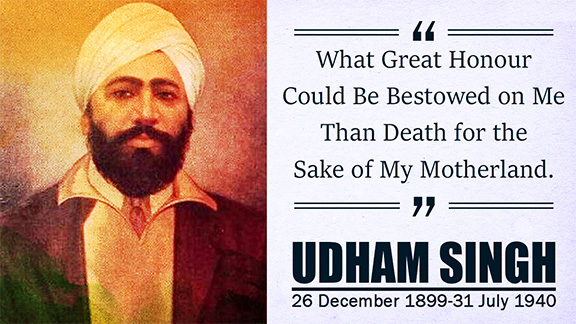Indian History
Udham Singh
- 03 Sep 2021
- 4 min read
Why in News
Amid criticism of the renovated Jallianwala Bagh memorial, some people raise questions over the statue of Shaheed Udham Singh installed at the Bagh.
Key Points
- About:
- Born in Sunam in Punjab’s Sangrur district in 1899, also referred to as Shaheed-i-Azam Sardar Udham Singh which means ‘Great Martyr’.
- He is regarded as one of the foremost revolutionaries of the Indian Freedom Struggle.
- Following the Jallianwala Massacre on 13th April 1919, he got profoundly involved in revolutionary activities and politics. He was deeply influenced by Bhagat Singh.
- He joined the Ghadar Party in 1924 to organise overseas Indians with the purpose of overthrowing colonial rule.
- In 1927, while returning to India with associates and weapons to carry out revolutionary activities, he was arrested for illegal possession of firearms and sentenced to five years in prison.
- On 13th March, 1940, Singh shot Michael O’Dwyer instead of General Dyer at a meeting of the East India Association and the Royal Central Asian Society at Caxton Hill.
- General Dyer, who ordered open firing on people protesting against the Rowlatt Act.
- He was sentenced to death and was hanged on 31st July, 1940 at Pentonville Prison in London.
- Ghadar Party:
- It was an Indian revolutionary organisation, with the aim to liberate India from British rule.
- ‘Ghadar’ – also written as ‘Ghadr’ in English – is an Urdu word for rebellion.
- The party was formed in the United States in 1913, by migrant Indians, mostly Punjabis. However, the party also included Indians from all parts of India.
- Motive was to wage a nationwide armed struggle against British colonialism in India.
- The party was established as the Hindi Association of Pacific Coast under the leadership of Lala Har Dayal with Baba Sohan Singh Bhakna as its president.
- The party is known for setting the foundation for future Indian revolutionary movements and served as a stepping stone for independence.
- Most members of the Ghadar party came from the peasantry who first began migrating from Punjab to cities in Asia like Hong Kong, Manila and Singapore at the dawn of the 20th century.
- Later, with the rise in the lumber industry in Canada and the US, many moved to North America, where they thrived – but also became victims of institutionalised racism.
- The Ghadar movement ‘inspired to transpose egalitarian values (Egalitarianism) of American culture in the social framework of colonial India’.
- Egalitarianism is a doctrine based on the notion of equality, namely, that all people are equal and deserve equal treatment in all things.
- It was an Indian revolutionary organisation, with the aim to liberate India from British rule.






-min.jpg)